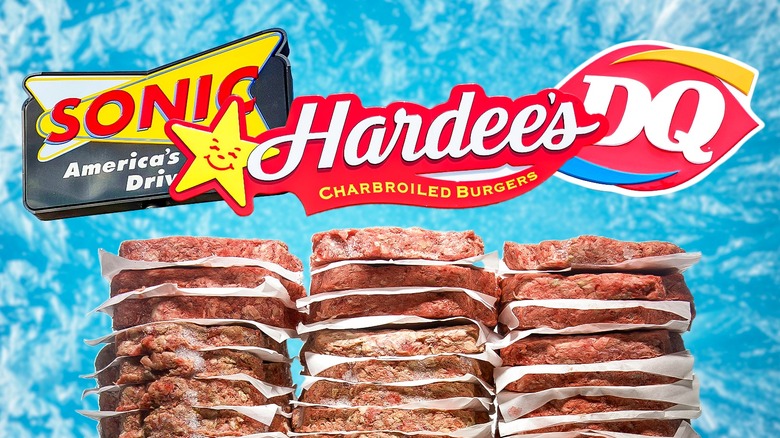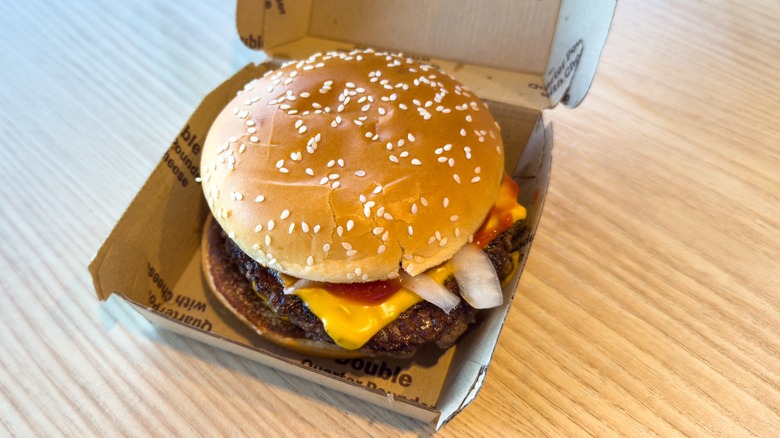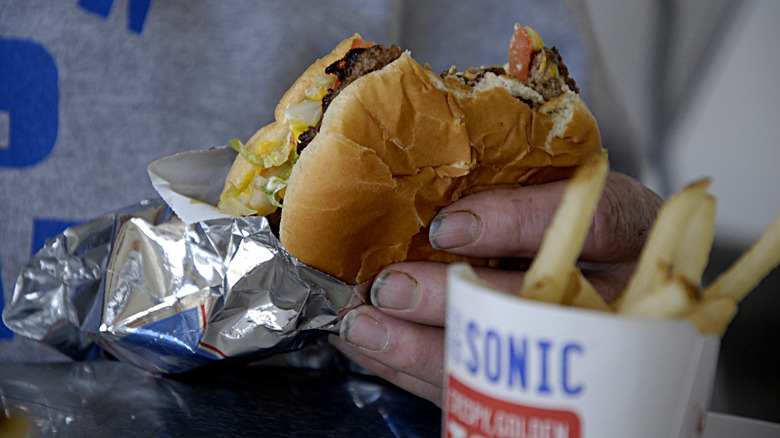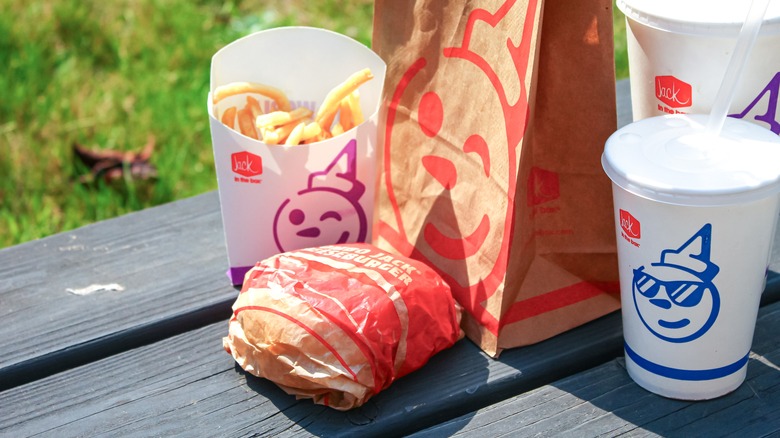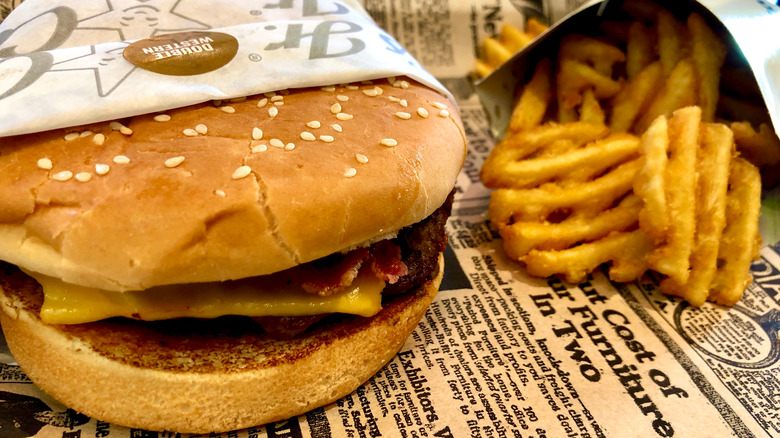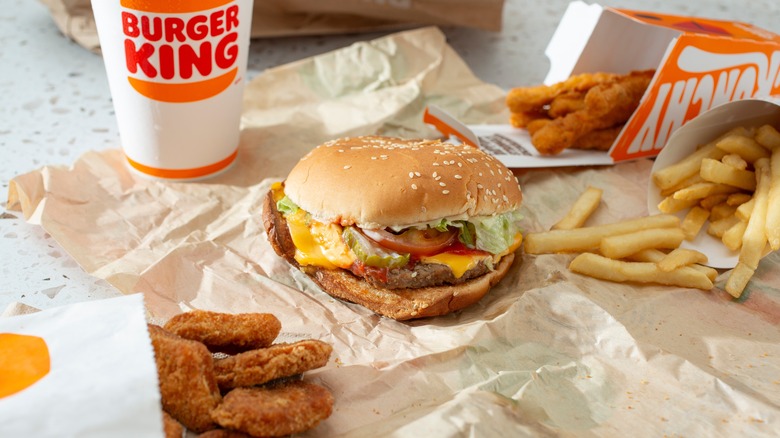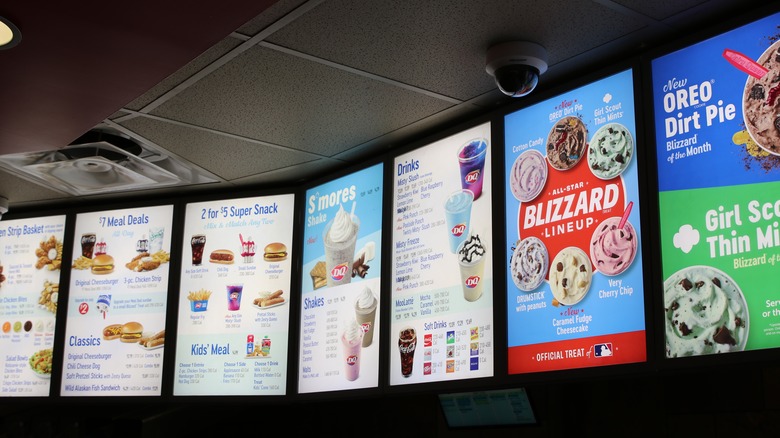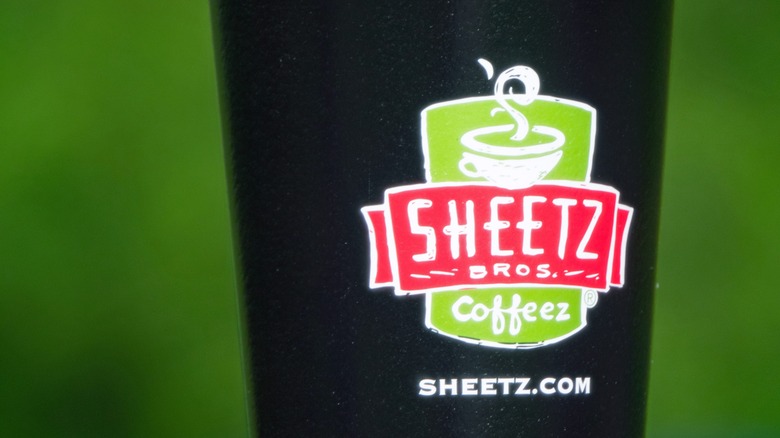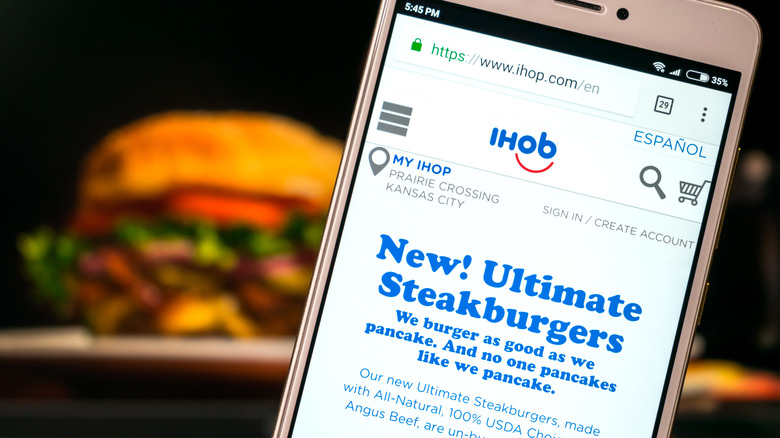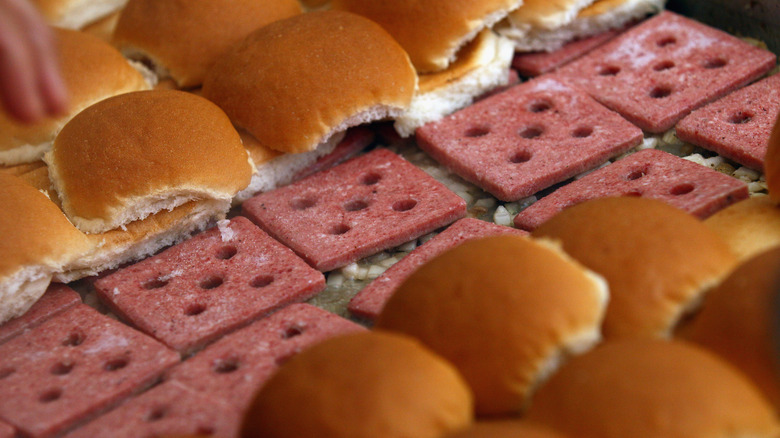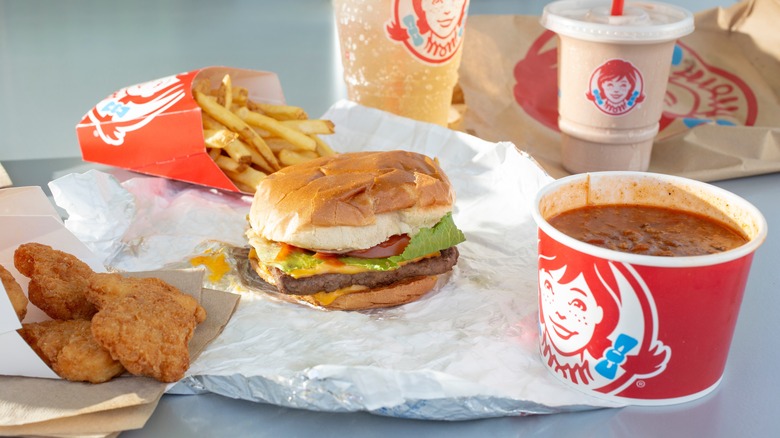Chain Restaurants That Secretly Use Frozen Burgers
If you pay attention to food advertising, you'll see it's common for restaurants that use fresh and not frozen beef in their burgers to tout that fact — "It's fresh! It's not frozen!" It hasn't been slowly succumbing to freezer burn before they feed it to you! Frozen beef has a bit of a reputation because fresh beef brings to mind juicy beef that hasn't dried out, while frozen beef could have been hiding in the freezer for who knows how long? Those chains that use frozen beef tend to be quiet about it, with a couple of notable exceptions.
The use of frozen beef, and in fact, frozen food in general is really very common in the restaurant industry. Transporting frozen food is one of the better ways to ensure quality, especially for food that has to travel far. Storing frozen food also allows restaurants to keep a supply of ingredients on hand that often suffer from supply chain issues. And, of course, storing frozen meat at a restaurant means the cooks there don't have to worry about meat going bad within a few days if orders slow down. Still, customers seem to like that fresh beef, so it's a good idea to learn who uses what. Here are some chain restaurants that secretly (or not so secretly) use frozen burgers.
McDonald's
McDonalds is the most open of the bunch about using frozen beef, if you know where to look. It announced in 2018 that it would start to use fresh and not frozen beef for some of its burgers, and its website openly discusses which burgers use frozen patties versus fresh. However, the chain's marketing tends to emphasize those fresh patties and not discuss the frozen ones, which makes sense; would you keep telling your customers they were getting frozen beef?
That being said, McDonald's does talk about its frozen patties in its FAQs. The patties are flash-frozen, which is a method of rapid freezing that helps preserve the quality and taste of the beef. The company also notes that the burgers go from flash-freezing to your individual burger within about two to three weeks. Even if you find your favorite Mickey D's burger uses a frozen patty, you can rest assured that it hasn't been lingering in the back of a freezer for a year — you're still getting some relatively recent beef.
Sonic
Take a look at Sonic's website, and you'll see claims on the menu that the beef is 100% pure beef. However, employees say that beef is frozen, which you won't find on the menu. Keep in mind, this isn't exactly nefarious; freezing meat doesn't make it unsafe, and there's no legal reason to state the patties aren't formed from fresh and never frozen meat. That being said, it is nice to know whether the patties start off frozen. The lack of information on the website makes it seem like the company is keeping a secret.
According to a Reddit AMA with a Sonic employee, just about everything comes in to Sonic locations frozen. That certainly helps with transportation, but it creates a new problem. If the employees don't cook the patties carefully, the centers can remain frozen — this happened with a chicken patty that one commentor ordered. While cooking fast food burger patties from frozen isn't unusual, it does mean that you need to be sure those patties are cooked thoroughly.
Jack in the Box
Jack in the Box has been using frozen beef for a long time; online comments from over a decade ago mention the frozen meat and claim that just about everything there is initially frozen. Even now, with new burgers and patty styles — the chain started selling Smashburger-type patties with thin and crispy edges — the meat still arrives at each location frozen. The only two changes are the new edge style on the smash patties, plus the fact that those patties are kept in smaller numbers.
Jack in the Box takes that convenience one step further, according to online comments, by pre-seasoning the raw patties. What you get at the restaurant is cooked for you, but everything else about the patty is done at whatever factory formed and froze the beef. Of course, the website makes no mention of this, but there are enough comments online to think that Jack in the Box really does use frozen burger patties.
Carl's Jr./Hardee's
Carl's Jr. and Hardee's are owned by the same company. The two started as separate chains, and Carl's Jr. eventually acquired Hardee's. Now, the two chains have similar menus, and apparently, similar ways of handling beef patties. If you check out the chain's websites, you'll see that it uses 100% beef for its burgers. However, you won't see any mention of it being fresh and not frozen beef. That's because, according to people who claim to be past and present employees, those patties are frozen.
One account on Reddit from a Hardee's customer gives visual proof of this. The Redditor posted a picture of a cheeseburger they'd gotten, and the patties have a layer of what looks like little bubbles along the surface of the beef, which the Redditor called "so disturbing looking." However, that bubbling is normal when you cook a frozen beef patty. As the patties thaw and cook, they release steam, which creates those little bubbles. Another account online noted that this is also why you can't order a rare burger there because the burger wouldn't cook properly — it would be partially frozen if it wasn't cooked all the way through.
Burger King
Burger King's advertisements like to mention those flame-grilled Whoppers made your way, so you'd think those tasty treats are made fresh just for you — this is almost the case. The burger patties are cooked at the restaurant, and you can customize your order and get a burger that is perfect for you, but those patties do apparently arrive frozen. Burger King makes no mention of frozen or fresh burger patties on its website, so it's up to people claiming to be Burger King employees online to clear up what the chain actually uses.
According to a few people online who claim to be employees or franchisees, the patties arrive frozen but raw. They're stored in the freezer and then fed through an automatic broiler. Depending on the type of broiler the location has, the patties may end up being cooked by themselves or at the same time as other patty types, such as the Impossible Whopper.
Dairy Queen
Dairy Queen doesn't discuss on its website whether its burger patties are fresh or frozen, and the company isn't exactly forthcoming when questioned about the state of the patties when they arrive at each DQ location. That in itself is a sign you're likely dealing with icy, frozen beef because a fast food company that serves fresh beef tends to want to advertise that fact. DQ does mention in its menu descriptions that the meat it uses is 100% real beef.
However, people claiming to be employees online say the patties do arrive frozen, and that goes for both sizes of burger available at the chain. The patties first travel over a flame on a conveyor belt, according to one account, and then sit in a warmer waiting for a customer to order a burger. Employees usually prepare a batch of burgers ahead of time, according to that account, so it won't take long for you to get your burger after you order.
Sheetz
Sheetz isn't a restaurant chain; it's a chain of convenience stores and gas stations on the East Coast and in the Great Lakes region of the U.S. However, it's known for its many food options, including a kitchen that makes food to order (There are also cafes at many locations, so it's close enough). People like Sheetz's food, including the burgers, and they're aware that what they're getting aren't going to be gourmet dishes. Customers trying Sheetz's burgers for the first time tend to be pleasantly surprised because they expect a basic convenience-store burger and instead get something that tastes pretty good.
Unfortunately, those pretty-good burger patties are also shipped to each location frozen. What's more, they're shipped pre-cooked. All the people at Sheetz have to do is thaw a patty and stick it in the microwave to heat it up for the customer. However, once customers find that out, they're not turned off. If anything, they find it kind of interesting that those burgers still taste great. There is a rumor that the grill marks on the patties are fake, but if they are, that's actually not unusual. A lot of fast food items that companies say are grilled are sent through a machine called a rotary brander that adds "grill marks" to items that will be frozen and shipped to restaurants.
IHOP
Do you remember IHOP's push to get people to buy its burgers in 2018? The chain briefly changed its logo from IHOP to IHOb, as in "International House of Burgers." IHOP already had burgers on the menu. However, the company wanted to revamp its lunch and dinner selections and get people to order those instead of treating IHOP as only a breakfast place. It introduced a line called "Ultimate Steakburgers" that used USDA Choice Black Angus Beef.
At the time, the company was already using frozen burger patties. You'd think a huge marketing scheme to promote burgers with this higher-quality meat would convince them to start using fresh beef, but nope. The company changed the form in which the beef was shipped; instead of patties, the Angus beef came in frozen logs that cooks would thaw, slice, and shape whenever a customer ordered a burger. The promotion did get the chain more attention, although it remained mainly a pancake joint for most people. One online review of the burgers wasn't that flattering, and a comment in the replies claimed that because the beef arrived frozen (not just at IHOP but also at several other restaurants), customers were really just eating expensive frozen dinners.
White Castle
White Castle is known for its square slider patties that have an innovative pattern of holes that allow the sliders to be cooked without being flipped. It's also known for its huge boxes of sliders that you can find in grocery store freezer sections. That doesn't automatically mean that White Castle uses frozen patties in its restaurants, but in this case, it's true. White Castle gets its meat for both the restaurant and grocery freezer burgers from the same facility. Frozen hunks of beef arrive at a central facility where they're chopped up and re-formed as those square patties. The patties are packed into boxes that clearly read, "Keep frozen," on the side. (Meat meant for the supermarket product is shaped into a square log with those five holes punched through the length of the log, frozen, and then sent to another facility for thawing and cooking.)
Using frozen patties makes sense for White Castle. If you watch its cooks make the sliders, you'll see them grab stacks of patties and quickly drop them in a grid formation on a bed of onions on the grill. You can't do that with fresh patties because the meat would bend and stick to other patties, but the White Castle patties remain flat and never stick. "Frozen" may not sound as great as "fresh," but frozen patties are what allow restaurant employees to make your late-night sliders so quickly.
Wendy's -- wait, what?
Wendy's accurately claims that it uses fresh and never frozen beef in its burgers, but that's only if you live in the contiguous U.S., Alaska, or Canada — any beef shipped out to Hawaii may be frozen. There are claims online that Wendy's has a private barge to get beef from Washington state to Alaska, but as of 2024, it doesn't have anything comparable for Hawaii. Commercial cargo shipping can take at least four days from a mainland port to Honolulu, and transportation to and from ports adds even more time. The use of frozen beef is limited, luckily. The company works with local suppliers to get fresh beef in different countries when possible.
However, those of you in areas that do get those fresh patties aren't completely out of the frozen woods yet. Think about what happens to those fresh patties when they've been on the grill for a while but haven't been sold. Are they refrigerated and tossed back on the grill the next day? Nope — the patties are apparently cooled down and frozen for use in the chili. This is anecdotal, but it makes complete sense; patties that are grilled, cooled, and reheated aren't going to taste very fresh on their own. Storing them safely and then cooking them with spices in chili is a legitimate use of the leftover meat. It's basically what most families have done with leftovers for decades, only on a larger commercial scale.
